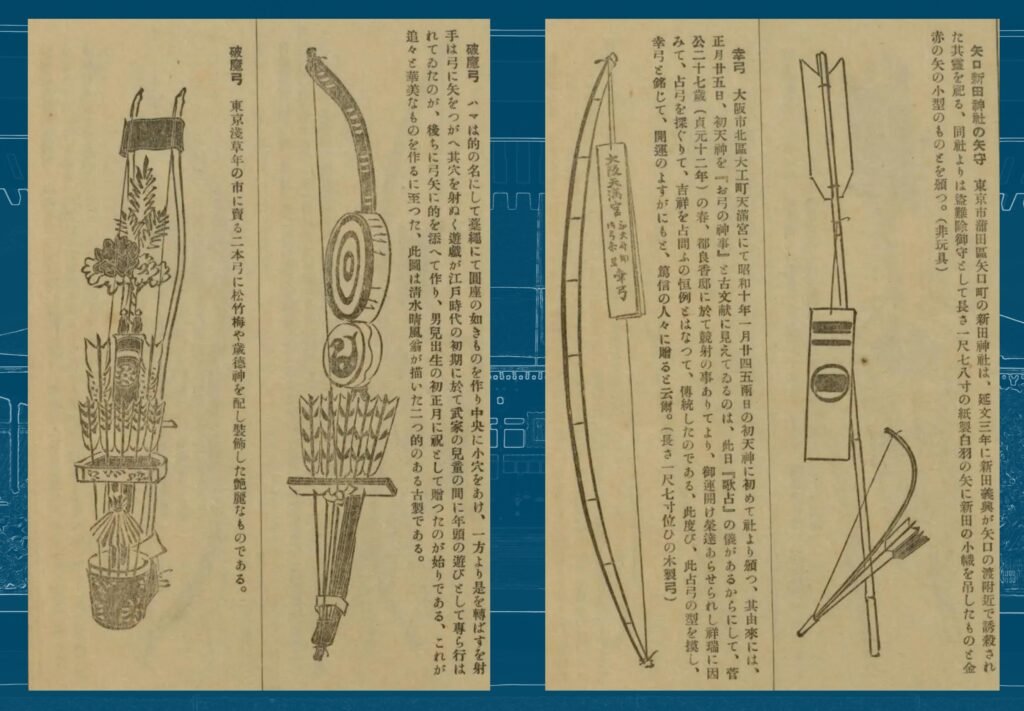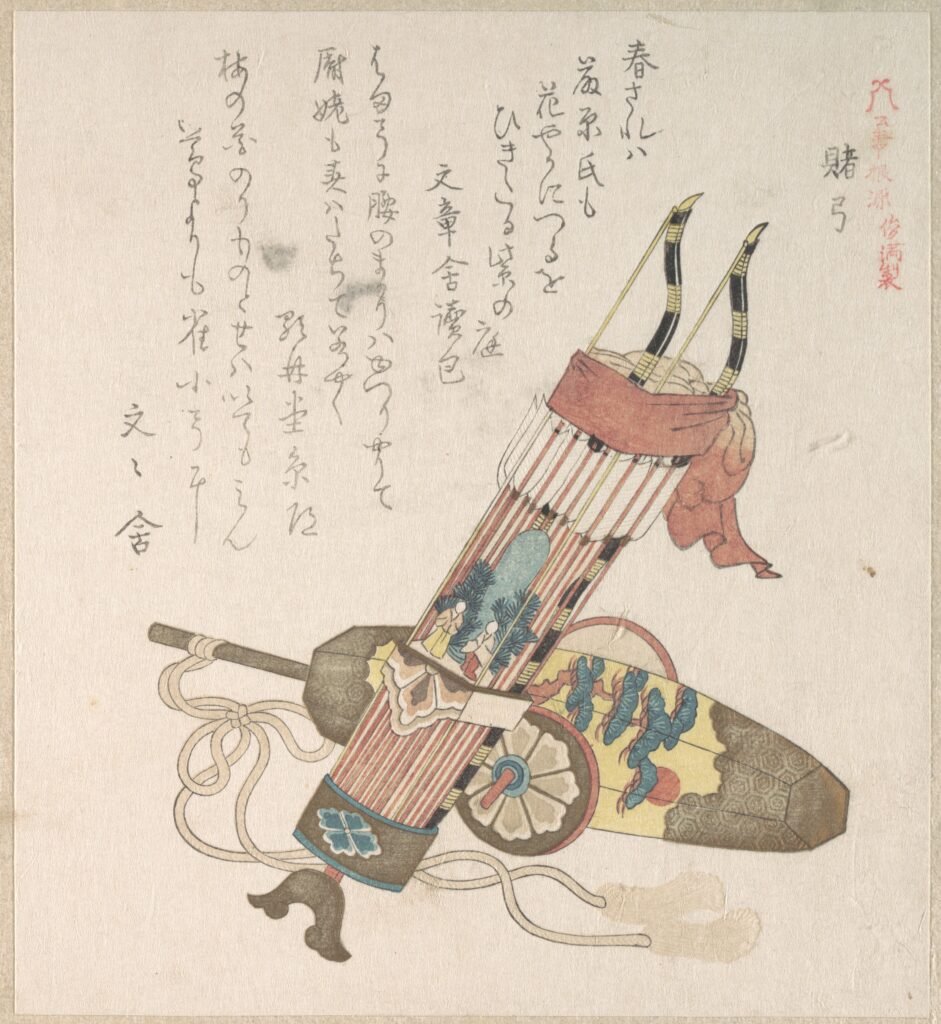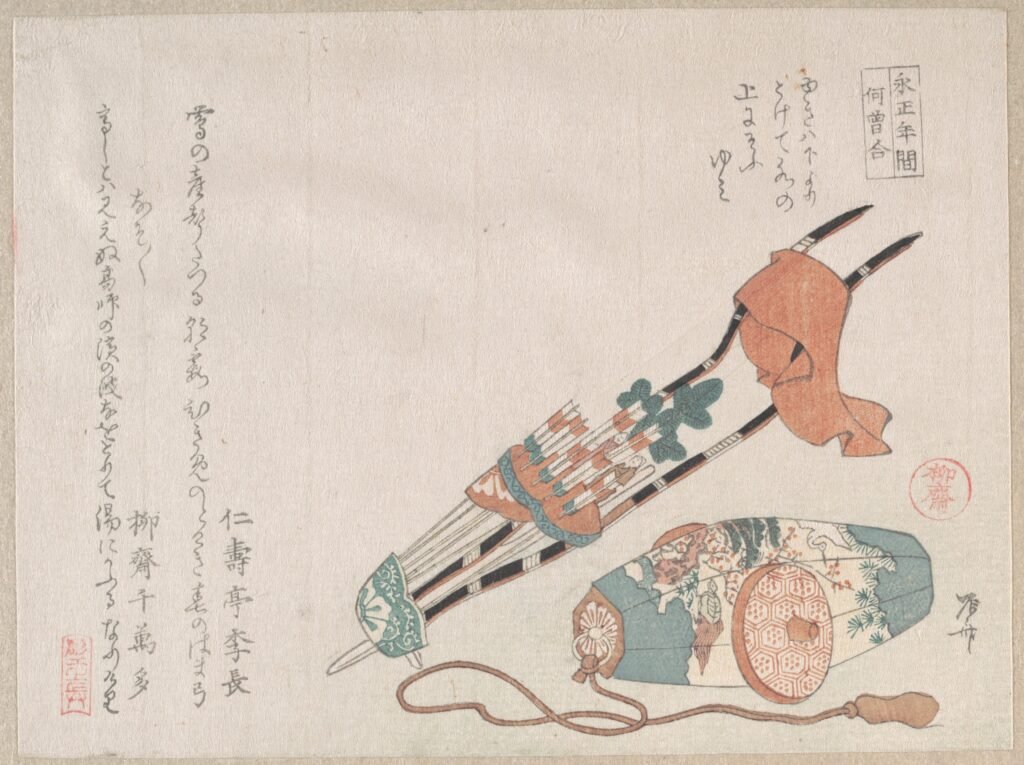The hamaya stands as an indispensable element of Japan’s New Year landscape. The meaning embedded in this single arrow transcends its role as a mere good luck charm, serving as a mirror reflecting the depths of Japanese spiritual culture. While the hamaya has gained widespread recognition among younger generations through anime like “Inuyasha,” where the priestess Kikyo wields sacred arrows, surprisingly few people truly understand its profound meaning and aesthetic value.
This article explores the hamaya as a uniquely Japanese cultural artifact from multiple perspectives, examining its historical background, contemporary significance, and potential as a design element.
The Essence of Hamaya – Japanese Philosophy of Protection Through Kotodama
Understanding the true nature of hamaya requires exploring both its linguistic origins and symbolic form. The word itself carries profound meaning through the Japanese belief in kotodama (the spiritual power of words), while the arrow as a physical object embodies directional force and purposeful intention.
The Prayer Embedded in Characters
The two characters forming “hamaya” (破魔矢) encapsulate the Japanese worldview. “Ha” (破) means “to break,” while “ma” (魔) signifies “evil things such as misfortune and illness.” This combination, while remarkably simple, carries powerful ritualistic meaning.
What proves particularly intriguing is the theory that the auspicious kanji characters were later applied to what were originally targets made of straw or wood called “hama.” This exemplifies the uniquely Japanese belief in kotodama (the spiritual power of words), demonstrating the Japanese linguistic sensibility of skillfully connecting sound and meaning.
Symbolism of the Arrow Form
The arrow form itself holds deep significance. An arrow flying straight symbolizes cutting through evil thoughts and the strong will to advance toward one’s goals. Additionally, from the act of “shooting,” positive meanings such as seizing opportunities and grasping good fortune have been attributed to the hamaya, embodying the Japanese philosophy that encompasses both defensive and offensive aspects.
Hamaya Through History – From Imperial Rituals to Folk Beliefs
The historical journey of hamaya reveals how sacred imperial rituals gradually transformed into widely practiced folk customs. This evolution demonstrates the Japanese cultural pattern of democratizing elite practices while maintaining their spiritual essence, from ancient court ceremonies to Edo period commercialization.
Ancient Jarai and Hamauchi Ceremonies
The origins of hamaya trace back to divination rituals called “jarai” (射礼) and “hamauchi” (破魔打) performed during New Year in ancient Japan. Children selected from various regions would shoot arrows at targets called “hama,” and the region whose child successfully hit the target was believed to enjoy a bountiful harvest that year.
In the imperial court more than 1,300 years ago, ceremonies involving shooting arrows with bows were already being performed at New Year. This practice stemmed from the ancient belief that bows possessed spiritual power to expel evil. The “meigen no gi” (鳴弦の儀), a ritual of expelling evil through the sound of plucking bow strings alone, continues to be practiced by the Imperial family today.
Commercialization in the Edo Period and Hiraga Gennai’s Contribution
Examining Edo period literature reveals the process through which hamaya became widely popularized. According to texts such as “Shishin Chimeiroku,” “Edo Chiri Sute,” and “Juman-an Yureki Zakki,” from around the Horeki period (1751-1764), what were sold as “Yoshioki no Ya” at tea shops in front of shrines were later, through Gennai’s proposal, manufactured using five-colored washi paper and bamboo, with black character strips from the Nitta family attached, and sold as talismans against evil.
Particularly noteworthy is the description in “Shinrei Yaguchi no Watashi,” adapted by Gennai. The scene where Nitta Yoshioki’s younger brother Yoshimune is saved by the family’s traditional “Suiha Hyoha” twin arrows illustrates that hamaya represented not merely good luck charms but also samurai pride and family honor.

Hamaya and Hamayumi – The Aesthetics of Sacred Paired Weapons
The relationship between hamaya (sacred arrow) and hamayumi (sacred bow) represents more than functional necessity—it embodies the Japanese concept of completeness through paired elements. Understanding this duality reveals deeper insights into how protective talismans gain their spiritual power through symbolic wholeness.
The Original Form: Harmony of Bow and Arrow
When discussing hamaya, we must not forget the existence of the “hamayumi” (破魔弓 – evil-breaking bow). Originally, hamaya were used as a set with hamayumi. The simple fact that arrows cannot be shot without a bow holds deep symbolic meaning.
While it has become common in modern times for only arrows to be distributed, this represents a kind of “sharing” from rituals where Shinto priests or Buddhist monks shoot hamaya with hamayumi. The hamayumi displayed during a boy’s first New Year is considered a more powerful protective implement than hamaya alone, embodying stronger wishes for the child’s healthy growth.
Integration with Buddhist Elements
In Buddhism, there exists a tradition that the golden bow and arrows held by Umarokya, one of the four yaksha serving Shōmen Kongō, represent the origin of hamaya. In Japan, where Shinto and Buddhism have merged, hamaya has become an entity encompassing elements of both religions. This duality symbolically represents the inclusiveness and fusion that characterize Japanese culture, telling the story of the Japanese spiritual capacity to absorb foreign cultures while sublimating them into unique forms.
The Role of Hamaya in Contemporary Times and Spatial Presentation
In modern Japan, hamaya has evolved beyond its traditional New Year context to serve multiple ceremonial and decorative functions. Its proper display requires understanding both practical considerations and spiritual protocols, bridging ancient wisdom with contemporary living spaces.
Diversifying Applications
In contemporary Japan, hamaya is employed in the following contexts:
- New Year Good Luck Charm: The most common form, received at shrines and temples during hatsumode (first shrine visit of the year), wishing for protection from evil and good fortune throughout the year
- Life Milestone Protection: Growth prayers for boys’ first New Year, Shichi-Go-San celebrations, and Boys’ Day (Tango no Sekku)
- Architectural Rituals: Evil protection at roof-raising ceremonies, talismans for new construction and renovation
- Business Protection: Good luck charms for office openings and new business ventures
Hamaya as Interior Design – Proper Display Methods and Spatial Aesthetics
When displaying hamaya, several important protocols must be observed. While placement on a kamidana (household Shinto altar) is fundamental, in modern living environments, attention should be paid to the following points:
- Height: Position slightly above eye level, showing consideration not to look down upon sacred objects
- Direction: Following onmyodo (yin-yang philosophy) wisdom, point arrow tips toward kimon (northeast) and ura-kimon (southwest)
- Environment: Select bright, well-ventilated locations and maintain clean spaces
- Installation Method: Use hamaya stands and demonstrate careful handling such as placing white paper underneath
Particularly important is never pointing the arrow tip upward. This creates a disrespectful form of shooting toward heaven, so hamaya must always be positioned downward or horizontally.
The Philosophy of Annual Cycles
In Japan, the custom exists of replacing hamaya with new ones each year. This practice stems not merely from commercial reasons but from the Japanese concept of purity based on dispelling “kegare” (impurity) and maintaining fresh protective power. This cyclical view of time reflects the Japanese life philosophy harmonized with natural cycles.
Hamaya as Design Material – Fusion of Tradition and Innovation
For contemporary designers and artists, hamaya offers a rich vocabulary of visual elements rooted in centuries of cultural meaning. The challenge lies in respectfully adapting these traditional forms for modern applications while preserving their essential spiritual and aesthetic qualities.
Analysis of Visual Elements
For designers, hamaya presents an attractive motif with the following elements:
- Linear Beauty: Minimal beauty inherent in simple, powerful forms
- Decorative Quality: Elegance and delicacy through accessories like feathers, braided cords, and paper strips
- Color Harmony: Dignified atmosphere created by traditional color schemes of vermillion, white, and gold
- Material Texture: Warmth emanating from natural materials such as bamboo, washi paper, and silk threads
Possibilities for Contemporary Arrangements
When creating contemporary arrangements of traditional hamaya designs, care must be taken not to compromise their essential meaning. For example, simple designs suited to minimal interiors or new interpretations using modern materials require maintaining balance between tradition and innovation.
In graphic design, hamaya silhouettes can be utilized for logo marks or developed as decorative patterns for New Year designs. In architecture and interior design, incorporating the linear beauty of hamaya into spatial composition enables expression of Japanese spirituality.

Kubo Shunman 19th century
Carrying a Millennium of Prayers into the Future
Hamaya represents a cultural device entrusted with Japanese prayers and wishes for over a thousand years. Each arrow embodies people’s earnest desires for family health, business success, and regional prosperity.
In contemporary society, even as science and technology advance and rational thinking becomes mainstream, faith in hamaya persists not as mere superstition but because it functions as a spiritual anchor for the Japanese people. Hamaya gives form to humanity’s universal desire to confront invisible anxieties and fears and overcome them.
As bearers of design and culture, how should we utilize the traditional motif of hamaya in the present and transmit it to the future? The answer lies not in formal succession but in understanding its essence and creatively reinterpreting it for new eras. The powerful message of hamaya to “break evil” should provide courage and hope in facing various challenges confronting contemporary society.
The hamaya transcends its role as a simple New Year decoration, continuing to live as a crystallization of Japanese wisdom that harmonizes protection and aspiration, tradition and innovation, spirituality and aesthetics. Its presence teaches us the importance of not forgetting reverence for invisible forces while living in the modern world. This single arrow will undoubtedly continue to protect the hearts of Japanese people and convey the depth of Japanese culture to the world.
References
Note: While this article maintains an English tone throughout, for those interested in exploring the original Japanese sources, we have included the following references that informed our research:
- E-Sogi website article “Mayoke no Ya ‘Hamaya’ to wa? Yurai to Kazaru Basho, Hogaku, Shobun Hoho” [The Evil-Repelling Arrow ‘Hamaya’: Origins, Display Locations, Directions, and Disposal Methods]
- Muramatsu Kokuzo-son Temple website article “Hatsumode de Juyo sareru Hamaya to wa? Kazarikata kara Shobun Hoho made Kaisetsu” [What is the Hamaya Received at New Year’s Shrine Visits? Explanation from Display Methods to Disposal]
- Kobo Tensho website article “Hamaya to Hamayumi no Chigai to wa?” [What is the Difference Between Hamaya and Hamayumi?]
- Nitta Shrine article “Yamori Hamaya no Ganso” [Yamori: The Origin of Hamaya]
Note: You can enjoy more articles about Japanese culture from Zenchantique through the following link:
[Additional Japanese cultural articles from Zenchantique]


